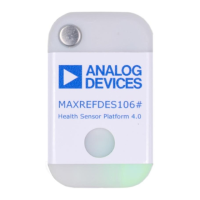Measurements
Photoplethysmogram (PPG)
The MAXREFDES106# has a highly configurable and very powerful PPG AFE with the MAX86178, which
includes programming high-current LED drivers and dual high-resolution optical readout signal-
processing channels with robust ambient-light cancellation. The user can quickly evaluate every aspect of
this fully programmable PPG AFE with the ‘Evaluation GUI’. This section discusses how to set up a basic
PPG measurement and provides an overview of how the measurement is structured at a high level.
See the MAX86178 data sheet for a more detailed description of the available feature-set of the PPG
AFE.
Overview
Fundamentally, a PPG measurement on the MAXREFDES106# can be broken down into frames. Inside
a frame, the PPG AFE drives an LED sequence and measures changes in light absorption through PDs
sampled by an ADC chain. Every aspect of this sequence is programmable, and each frame is organized
into a sequence of measurement blocks.
A frame can consist of up to six sequential measurements blocks.
Figure 22. Frame with Six Measurements, M1 to M6
Each measurement block is essentially an exposure, like in a traditional camera. It has a certain exposure
time, and up to two LEDs can be driven and two PDs sampled in each exposure. These exposures can
be used separately or combined with measurement averaging. This allows a single optical AFE to support
multiple optical measurements in a compact, energy-efficient design. Measurement settings can be
finetuned manually in the Raw Mode or adjusted algorithmically by enabling the AGC in the Algo Hub
Mode. See the section PPG Mode for details on these modes.

